Oktoberfest has done pretty well. Having started life as a celebration for a royal wedding over two hundred years ago, it’s now the second biggest festival on Earth after the Rio Carnival. Millions of people flock to Munich each year, and there are countless other Oktoberfest imitations around the world. Maybe something about having beer as the centerpiece of the festival?
The real Oktoberfest now starts in September– it turns out October is a bit grim. What you need to wear will depend on where you’re celebrating. If you’re going to an ‘Oktoberfest party’ at a friend’s house, you can probably wear whatever you want– but what should you wear to the real thing?
For other festivals this is more complicated, but Oktoberfest basically has two outfits, and you can probably already picture them both. There are two trachten (costumes) for this event– lederhosen and dirndl. Here we look at what they are, whether you need to wear them, and how to wear them correctly.
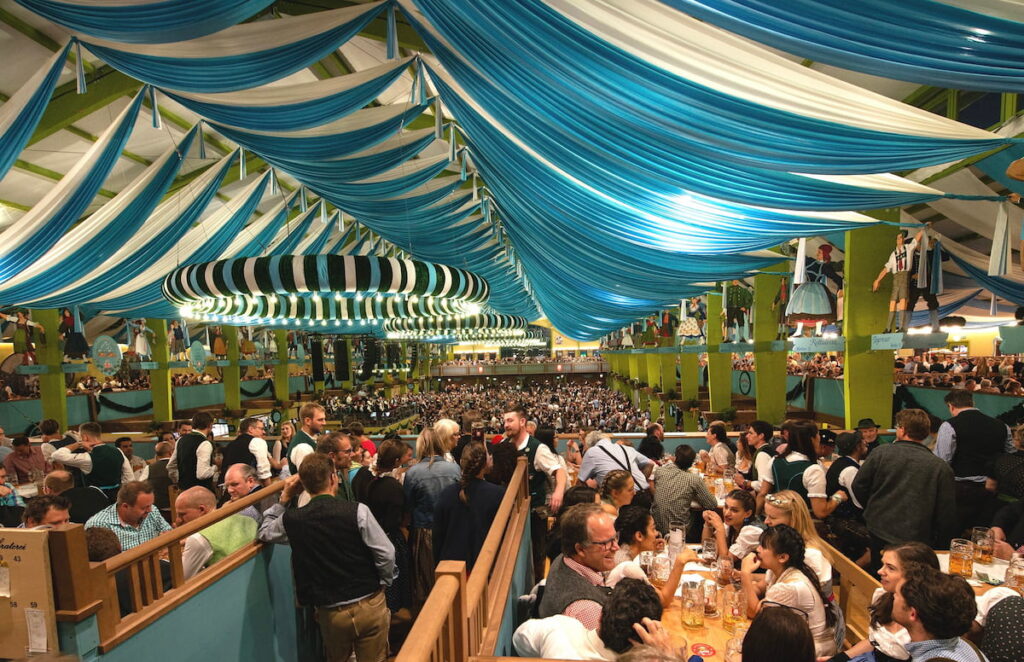
What Are the Traditional Outfits for Oktoberfest?
Lederhosen is made up of (normally) leather shorts with suspenders, with a shirt underneath. It’s the most quintessentially German outfit, and what you’d wear if you were just dressing up as a German. They’re also worn by actual Germans to special events, especially Oktoberfest. Traditionally the outfit for men, it’s the 2020s now, so you see some women wearing lederhosen, or ladyhosen.
Dirndl is a lesser-known word, but most people still know the outfit. It involves a blouse, a bodice and skirt (or a dress) and an apron. Foreigners might think of it as a ‘sexy German barmaid’ outfit, but you shouldn’t confuse the two (more on that later). This has always been the outfit for women, and nowadays it still is. If you see a man in a dirndl, it’s probably a bachelor party, and he’s probably offending someone.
Both of these outfits started as peasant outfits, and were not cool when Oktoberfest began. They came back into fashion though, and by the end of the 19th century were the official dress of the festival.
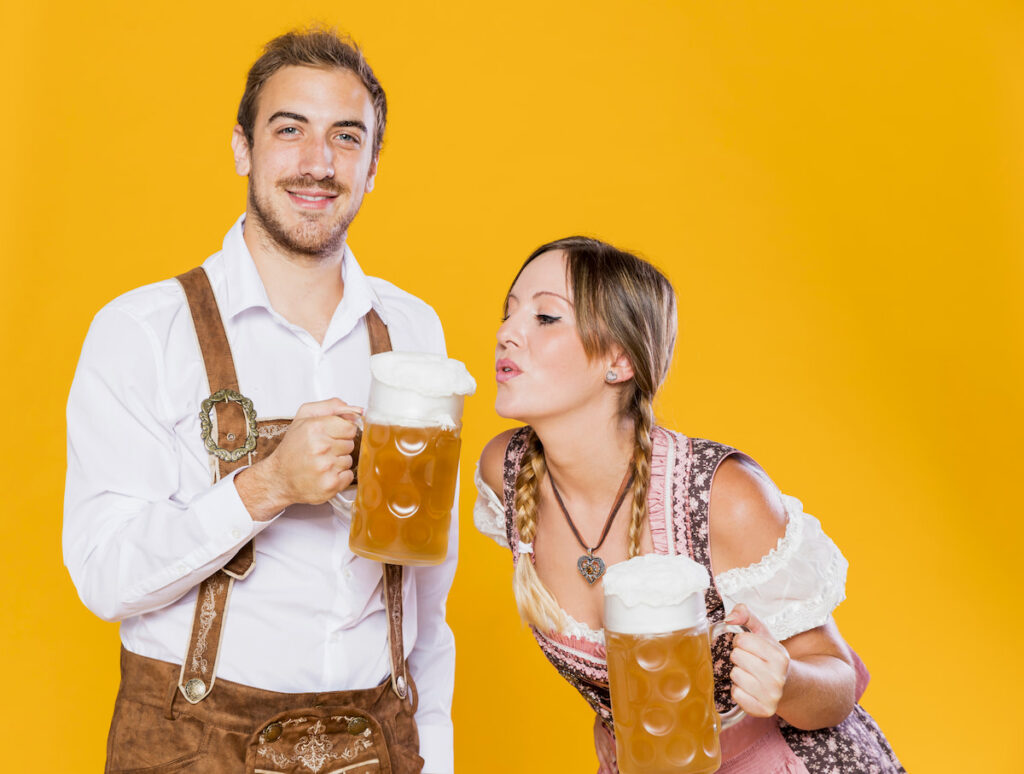
Should I Wear Lederhosen or a Dirndl to Oktoberfest?
Yes, yes you should. Some stereotypical clothing is only worn by tourists, but most Germans own one of these, and wear them to Oktoberfest, so wearing one shows respect for tradition. That doesn’t mean you have to though– plenty of people wear normal clothes, so you won’t feel uncomfortable if you do too. But if you only go to one Oktoberfest in your life, wearing the tracht will make it a more memorable experience, and your photos will be way better.
One thing to avoid is the cheap fancy dress costumes that imitate the real thing. Most people around you will either be wearing normal clothes, or official trachten that look great. To the untrained eye, your cheap costume might seem similar, but Germans will mark you out as a clueless tourist immediately. If you’re proud of being a clueless tourist then go for it, but otherwise we’d save the costumes for Halloween.
How to Wear Lederhosen and Dirndls Correctly
Some rules are flexible, but others are stricter, so there are some conditions for your outfit to be considered authentic. Price is also an issue here. You can buy a whole new outfit, but it’s likely to cost over $100, and top-end ones can cost hundreds. You might not mind this, but if you’ll only be wearing it once, you might prefer a cheaper way.
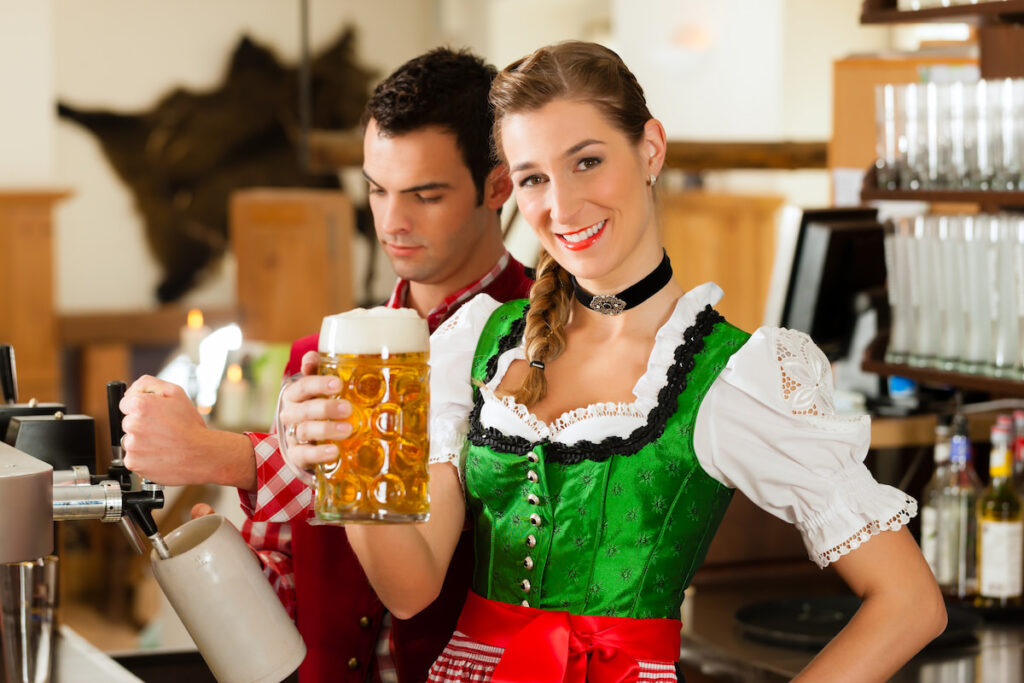
You can rent, or buy them secondhand, but that’s sometimes frowned upon. Probably because they’re tight-fitting outfits that people get hammered in, throw beer over, urinate clumsily in, and occasionally vomit in. We’ve learned how to wash clothes for a reason though, so it’s fine to do that if you prefer. You can also make much of the outfit from clothes you already own, to keep costs down. Whether you’re getting your outfit brand new, or second-hand, here’s what you need to do to get it right, and some tips to help you enjoy the day.
How to Wear Lederhosen
The shirt is easy– traditionally checked in blue and white, but often other colors such as red and black, or plain white. Roll the sleeves up to complete the look.
The pants are the key part, and you’re unlikely to already own any. You need leather shorts– chamois or deer skin for the connoisseurs, but cowskin is just as common these days – which stop just above or below the knee. Longer ones used to be a thing, but are very rare these days. There’s a flap on the front, which you’ll appreciate when you’re in the bathroom for the twentieth time.
They typically come with suspenders that have a band across the middle. They’re usually decorated, and often have a chain of different links. These might be family heirlooms, so never make fun of someone else’s, in case you offend their ancestors. To save money you can just wear shorts in a similar style, but it won’t be lederhosen.

Quick Tip : You don’t want them too tight, as there’s a lot of jumping on tables and dancing at Oktoberfest. If you can’t squat in them, maybe go up a size.
Wear woolen-style socks that cover your calves– usually white, they can also be gray, or match your shirt color. You’re supposed to wear Haferl shoes, but if you wear some kind of (brown or black) leather loafers, people probably won’t notice. If you do decide to splash out on authentic shoes, you can at least wear them with other outfits to get more use from them.
Add a traditional Alpine hat if you want– and a feather to look extra awesome. This isn’t an essential part of the outfit, but looks great, and is fun once you’ve had a few. They also help with bad weather.
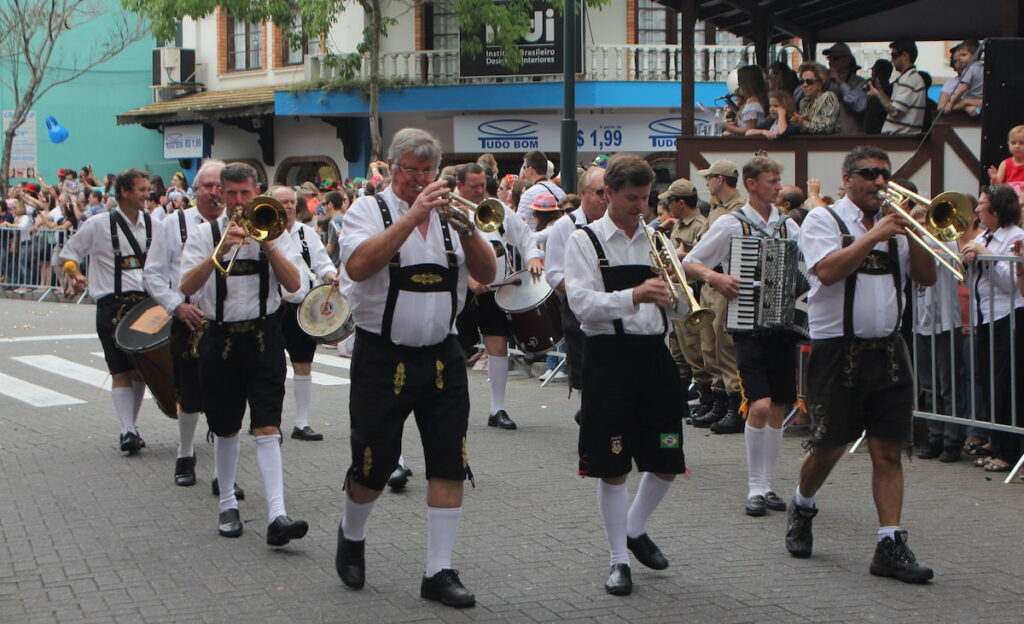
How to Wear a Dirndl
Another easy start– the blouse. White, with short puffy shoulders, and showing plenty of cleavage, or balkon (balcony). These rules are flexible if you don’t have a shirt like this, feel more comfortable covering up a bit more, or prefer a different color that matches the rest of your outfit.
The dirndl itself is the dress, or you can get the bodice and skirt separately. The bodice is recognizable for its laces, and should cover the boobs, not sit under them– one thing that’ll give you away if you get a ‘sexy German barmaid’ costume instead. Traditionally made of wool for the peasants, or silk for the upper classes, nowadays they’re often cotton or linen.

Quick Tip : The skirt or dress comes in mini, midi, or maxi lengths. The mini is less common, as you tend to spend a lot of time on tables, and it’s nice to leave something to the imagination. If you do go for it, we recommend little shorts underneath.
The apron needs to match, so it’s often sold with the dress. Tied with a ribbon, the knot placement tells people your relationship status (curiously there’s no equivalent for men). On the left if you’re single, the right if taken, the back for barmaids (or widows), and the front, mystifyingly, tells people you’re a virgin. So wear it on the back to get bothered (for beer), on the left to get bothered (for other stuff), on the front to get bothered (by jokes), and on the right to get less bothered.
Knee-high stockings are traditional, you can also wear tights, or nothing on the legs. Check the weather before you leave. The shoes are pretty simple for women. Avoid heels and sneakers. Black or white flat shoes to keep it comfortable– there’s a lot of standing and dancing on uneven wooden floors/tables, and sometimes broken glass on the floor.
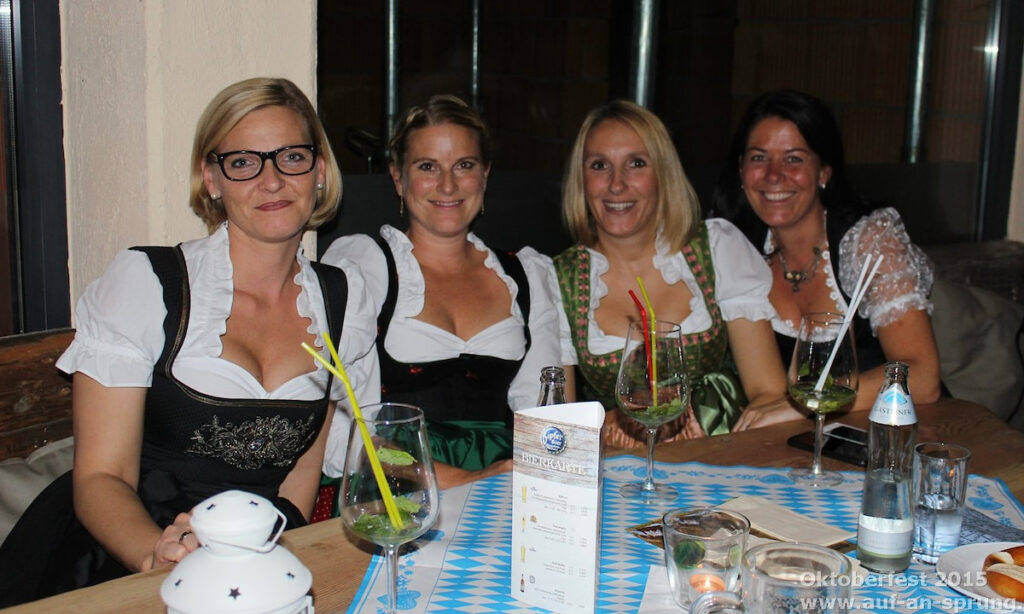
You should also get a wiesn glupperl– clothes pegs with a cute little decoration and your name burned into them. They top off the outfit, and are a lovely souvenir that’ll definitely fit in your luggage.

Quick Tip : Most beer tents don’t let you take large bags in, so just take a small purse with the essentials.
Don’t Forget the Weather
These outfits come with some layers already included, and inside the beer halls you’ll be fine. You still need to get there and back though, and the move to September hasn’t stopped the evenings being cold. Hats, scarves, undershirts, cardigans, or even a vest can be added to your lederhosen to give you the extra warmth you need. Tights, a petticoat, a cardigan, scarf or pashmina go well with a dirndl.
On Tracht for a Great Time
Oktoberfest is great fun whatever you’re wearing, but get your clothing right and you can immerse yourself in the culture and tradition a bit more. It’s also more fun, and doubles up as an easy conversation starter. If you’re worried about the expense, use some of our shortcuts, and remember that you’ll have an extra fancy-dress costume for whenever you need one. Stay safe, enjoy the one beer you’ll sip slowly throughout the day, and enjoy your bash in Bavaria!
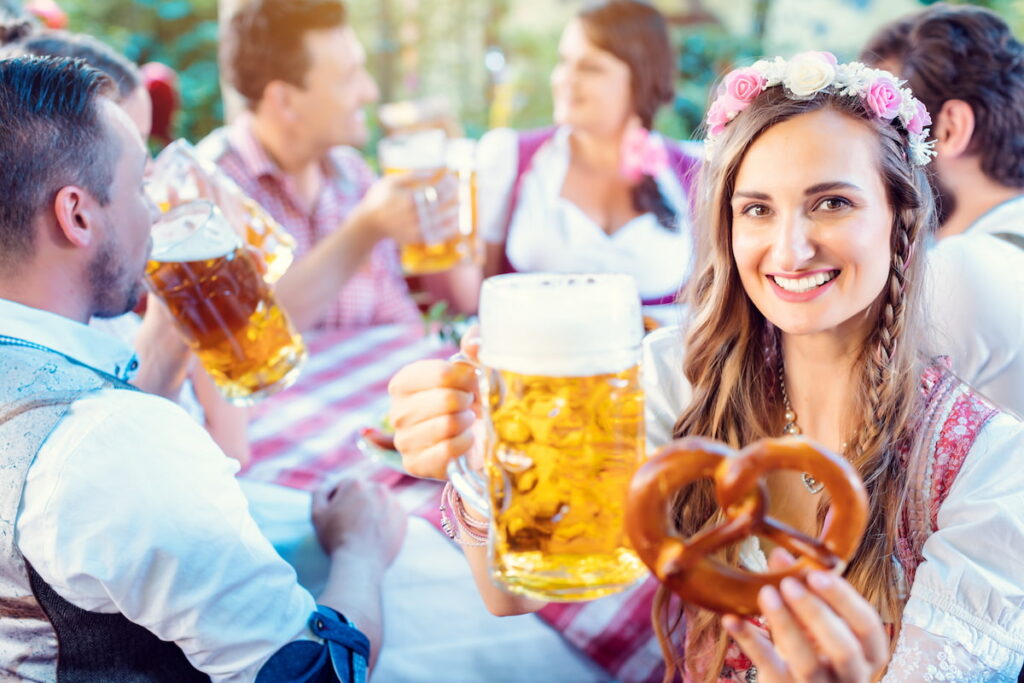
We hope you have a great time at Oktoberfest, and that our guide helps you get your outfit just right. We sadly don’t sell lederhosen or dirndls, but for your shirt, or any other apparel you need, have a look at our website, where you get everything at a great price. For more ideas, follow us on Instagram– @wearewordans.












